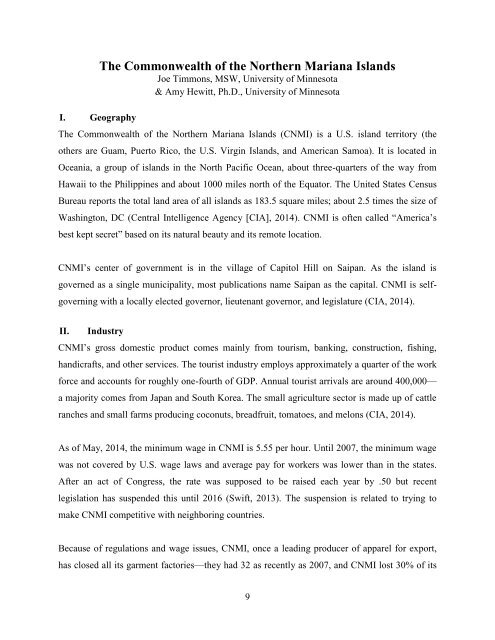Combined-Territories
Combined-Territories
Combined-Territories
You also want an ePaper? Increase the reach of your titles
YUMPU automatically turns print PDFs into web optimized ePapers that Google loves.
I. Geography<br />
The Commonwealth of the Northern Mariana Islands<br />
Joe Timmons, MSW, University of Minnesota<br />
& Amy Hewitt, Ph.D., University of Minnesota<br />
The Commonwealth of the Northern Mariana Islands (CNMI) is a U.S. island territory (the<br />
others are Guam, Puerto Rico, the U.S. Virgin Islands, and American Samoa). It is located in<br />
Oceania, a group of islands in the North Pacific Ocean, about three-quarters of the way from<br />
Hawaii to the Philippines and about 1000 miles north of the Equator. The United States Census<br />
Bureau reports the total land area of all islands as 183.5 square miles; about 2.5 times the size of<br />
Washington, DC (Central Intelligence Agency [CIA], 2014). CNMI is often called “America’s<br />
best kept secret” based on its natural beauty and its remote location.<br />
CNMI’s center of government is in the village of Capitol Hill on Saipan. As the island is<br />
governed as a single municipality, most publications name Saipan as the capital. CNMI is selfgoverning<br />
with a locally elected governor, lieutenant governor, and legislature (CIA, 2014).<br />
II. Industry<br />
CNMI’s gross domestic product comes mainly from tourism, banking, construction, fishing,<br />
handicrafts, and other services. The tourist industry employs approximately a quarter of the work<br />
force and accounts for roughly one-fourth of GDP. Annual tourist arrivals are around 400,000—<br />
a majority comes from Japan and South Korea. The small agriculture sector is made up of cattle<br />
ranches and small farms producing coconuts, breadfruit, tomatoes, and melons (CIA, 2014).<br />
As of May, 2014, the minimum wage in CNMI is 5.55 per hour. Until 2007, the minimum wage<br />
was not covered by U.S. wage laws and average pay for workers was lower than in the states.<br />
After an act of Congress, the rate was supposed to be raised each year by .50 but recent<br />
legislation has suspended this until 2016 (Swift, 2013). The suspension is related to trying to<br />
make CNMI competitive with neighboring countries.<br />
Because of regulations and wage issues, CNMI, once a leading producer of apparel for export,<br />
has closed all its garment factories—they had 32 as recently as 2007, and CNMI lost 30% of its<br />
9



